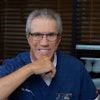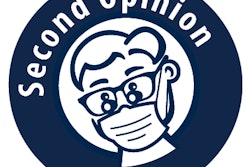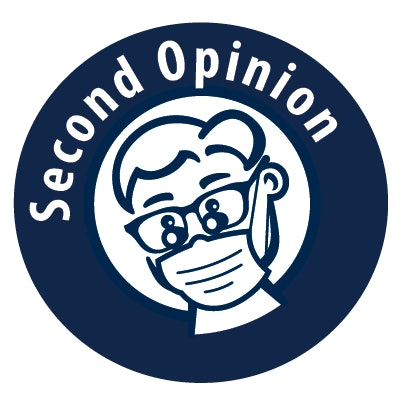
Editor's note: This is the second in a three-part series about how COVID-19 is changing dentistry and what that could mean for practices when they reopen their doors. Be sure to check out part 1.
As a dentist during COVID-19, you are likely developing a strategy to prepare for a back-to-basics approach to dentistry. Key to this is focusing on patients' acute needs, attracting and retaining patients, and maximizing efficiency.
With those thoughts, enter teledentistry, a practical way to rise to the challenges presented by COVID-19 and ensure that your dental practice will thrive for many years to come.
"Providing virtual care with teledentistry is critical for practice efficiency and patient relations," said practice management consultant and dental insurance expert Teresa Duncan. "It allows you to provide care to patients without a visit to the office. This keeps your chair open for restorative procedures. With today's infection control costs, it's important to make the most of each appointment to avoid extra costs. It's also a strategy to stay connected to your patients. Now more than ever, it's essential to show them that you are here for them, even if office visits are limited. Rather than just saying, 'Sorry, we'll call you when we're open,' you can now put the patient's mind at ease. This is where customer service meets patient care."
Teledentistry can help you practice dentistry that not only delivers great patient experiences but also provides increased practice efficiency.
Adopting teledentistry equals increased efficiency
What does adopting teledentistry mean exactly? Teledentistry is way more than setting up video chats with your patients. It's about strategically implementing new technologies to provide smarter and more efficient care.
Incorporating teledentistry into your practice is like adding a digital chair (or two!) and a few extra care coordinators. It creates an automated, virtual triage so your front desk team members don't need to be clinical experts, which is especially important if they're working from home.
As an example, with Wally's teledentistry services, patients chat with us through our messaging system so we can understand exactly what their concern is. We then connect the patient with a dentist for a virtual visit to decide how to manage and address the issue based on the individual and his or her risk factors.
Patients with an urgent case will have a very different experience when their dentist uses teledentistry. Traditionally, a patient will call the office, potentially wait for a call back, and then schedule a consultation with the dentist. That consultation takes up chair time, sometimes for cases that can be addressed at home.
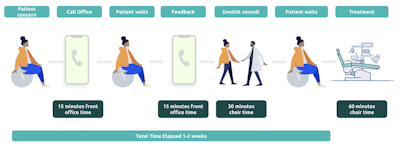

Previous paradigm. Illustration courtesy of Wally Health.
By using teledentistry, patients can quickly share their concern through a chat interface, then connect immediately and quickly with their dentist through video. For the dentist, this means he or she can complete most of the emergency/limited exam without the patient taking up valuable chair time. And if that patient needs to come into the practice, he or she can be much more efficient in coordinating that care, which limits the cost for the practice.
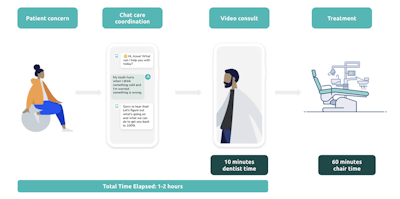

Teledentistry paradigm. Illustration courtesy of Wally Health.
Dentists who leverage virtual visits find that it saves them time, reduces the need for personal protective equipment, and can keep their physical chairs open for more profitable visits. Teledentistry can make your entire team more productive and take on some of the load of scheduling, coordinating care, and communicating with patients. As a result, your patients will feel like you're on their side and be more likely to turn to you when they have an urgent dental problem.
Teledentistry strengthens patient-dentist relationships
Did you know that the majority of patients say they don't have a strong relationship with their dentist? Recently, a patient reached out with throbbing tooth pain that was keeping her from sleeping. The patient had been trying to contact her regular dentist for days and had even tried using an emergency coordinator for a well-known dental service organization (DSO). Unfortunately, she still hadn't successfully connected with a dentist.
However, after connecting through teledentistry, a dentist was able to prescribe antibiotics and an antibiotic mouthwash, as well as schedule the patient for a tooth extraction a few days later. By incorporating teledentistry and providing an accessible and convenient way to help that patient during her acute issue, the dentist gained the trust and business of that patient.
Teledentistry allows practices to follow up with every patient after a treatment. Even if the person didn't have a procedure, many dentists use telemedicine communications to send quick notes to their patients asking how they're feeling.
All of this adds up to a modern dental experience that patients will seek out and tell their friends and family members about. When patients have acute needs, they will turn to the dentists who are most conveniently accessible. And when patients are ready to come back into the office for large elective treatments again, they will remember how well you treated them and will be ready to trust you with their ongoing dental needs.
Chelsea Acosta Patel is the head of experience at Wally Health, a dental membership and teledentistry company, where she applies her experience in innovation, healthcare, and insurance from working with Clayton Christensen. She can be reached at [email protected].
The comments and observations expressed herein do not necessarily reflect the opinions of DrBicuspid.com, nor should they be construed as an endorsement or admonishment of any particular idea, vendor, or organization.


